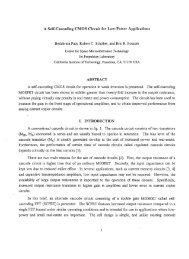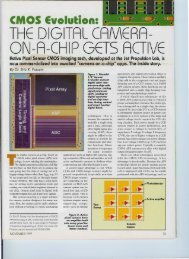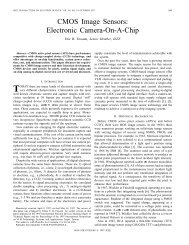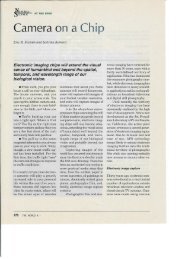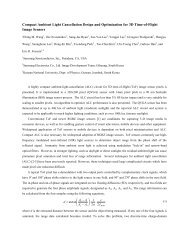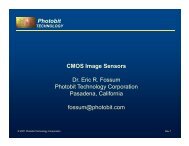Infrared readout electronics for space science sensors - Eric Fossum
Infrared readout electronics for space science sensors - Eric Fossum
Infrared readout electronics for space science sensors - Eric Fossum
You also want an ePaper? Increase the reach of your titles
YUMPU automatically turns print PDFs into web optimized ePapers that Google loves.
typically obtained in state-of-the-art low background IR FPAs. Lower noise levels have been reported in a few papersdiscussed below. As a rule of thumb, <strong>for</strong> a given focal-plane power dissipation, <strong>readout</strong> noise increases with <strong>readout</strong> rate.There are several noise processes introduced by the <strong>readout</strong> <strong>electronics</strong> 16]. The 1/f noise (sometimes called excess orflicker noise, and whose power spectrum is given by 1/f°, x 1-2) in <strong>readout</strong> unit cell <strong>electronics</strong> is an important issue <strong>for</strong>low background applications involving long integration times (greater than 100 milliseconds). For most unit cell circuitsused in JR FPAs, the input-referred noise electrons due to the 1/f noise is directly proportional to integration time, makingthe JR FPA noise significantly larger <strong>for</strong> longer integration times.Other temporal noise sources that are of concern <strong>for</strong> <strong>readout</strong> <strong>electronics</strong> are transistor white noise (or channel thermalnoise), and reset noise. The effect of transistor white noise can be minimized by reducing the integration capacitances.Reset noise is introduced whenever a switch is used to preset a voltage on a capacitor, and has a voltage r,m.s. value equalto (kT/C)2, where C is the capacitor value, and T is the temperature. This so-called kTC noise can be eliminated bycorrelated double sampling discussed later.Fixed pattern noise (FPN) is associated with randomly distributed, time-invariant offsets in unit cell circuits (in additionto FPN associated with detector arrays). FPN due to gain non-uni<strong>for</strong>mity and non-linearity can ultimately lead to lessthan-BLIPper<strong>for</strong>mance [7]. FPN and temporal noise can also be introduced by on-chip clocking signals used to drive theJR FPA <strong>readout</strong> <strong>electronics</strong>. Careful layout and separation of digital and analog circuits are required to minimizeclocking noise. Low FPN is desirable <strong>for</strong> scientific sensor <strong>readout</strong> <strong>electronics</strong>.Another source of noise is the so-called amplifier glow problem. Due to hot electrons in the output amplifier transistor(s),photons that are approximately at the semiconductor band gap energy are emitted. These photons can travel a significantdistance be<strong>for</strong>e being reabsorbed by the semiconductor, giving rise to a pseudo-dark current (with associated shot noise) inthe general vicinity of the <strong>readout</strong> amplifier. In addition to being absorbed in the <strong>readout</strong> <strong>electronics</strong> circuits, thesephotons can also be sensed by the infrared detectors. In general, reduction of bias currents and voltages can ameliorateamplifier glow.2.4 Dynamic RangeDynamic range is defined as the ratio of the maximum signal that can be integrated to the r.m.s. noise floor. If this ratiois R, then dynamic range is in decibels (dB) is 20 log R. The required dynamic range is determined by the application,and is typically the ratio of the brightest feature to be observed to the weakest. Users prefer the largest possible dynamicrange, but are often limited by either available analog to digital (A/D) converters to under 16 bits (96 dB), by the <strong>readout</strong><strong>electronics</strong> unit cell storage capacitor technology to a lesser value, typically 70-80 dB, or by requirements of linearity,which can be very stringent <strong>for</strong> scientific applications (e.g. less than 1% integral non-linearity).2.5 Readout RateReadout rate is typically related to the allowed on-focal-plane power dissipation <strong>for</strong> high <strong>readout</strong> rates, array <strong>for</strong>mat,integration time, and by practical system considerations <strong>for</strong> low read out rates. For large <strong>for</strong>mat ( 256x256) staringarrays, simple integrate and <strong>readout</strong> JR FPAs often require data rates in excess of 100 kpixels/sec. The data rate can alsobe high <strong>for</strong> JR FPAs operating at LWJR band, where the integration time can be short. Usually, <strong>for</strong> simple integrate and<strong>readout</strong> JR FPAs, <strong>readout</strong> rates of the order of 10-100 kpixels per second are utilized. For JR FPAs with multiple, nondestructivesampling, and <strong>for</strong> high background applications, higher <strong>readout</strong> rates are required. Typically, scientific JRFPA <strong>readout</strong> does not exceed 1 Mpixel/sec.2.6 Operating TemperatureThe operating temperature of the IR FPA is typically set by the detector cutoff wavelength. Longer cutoff wavelengthsrequire colder operating temperatures to reduce detector dark current. Detector dark current introduces additional shotnoise and increases the dynamic range requirement since the dark current integration is summed with the photosignal andthe total charge must be accommodated by the unit cell capacitance. A practical lower bound on the operating264 / SPIE Vol. 2020 <strong>Infrared</strong> Technology XIX (1993)



